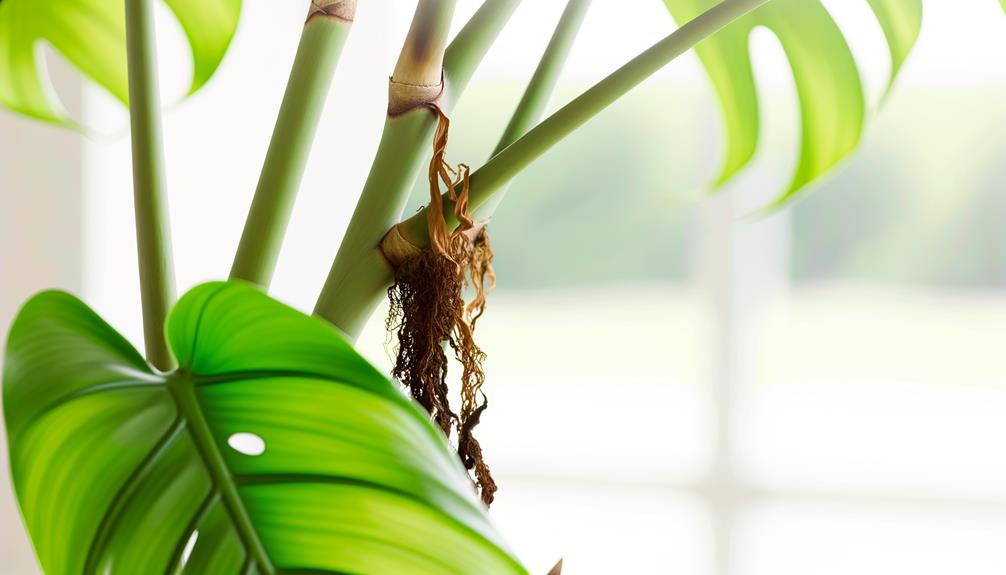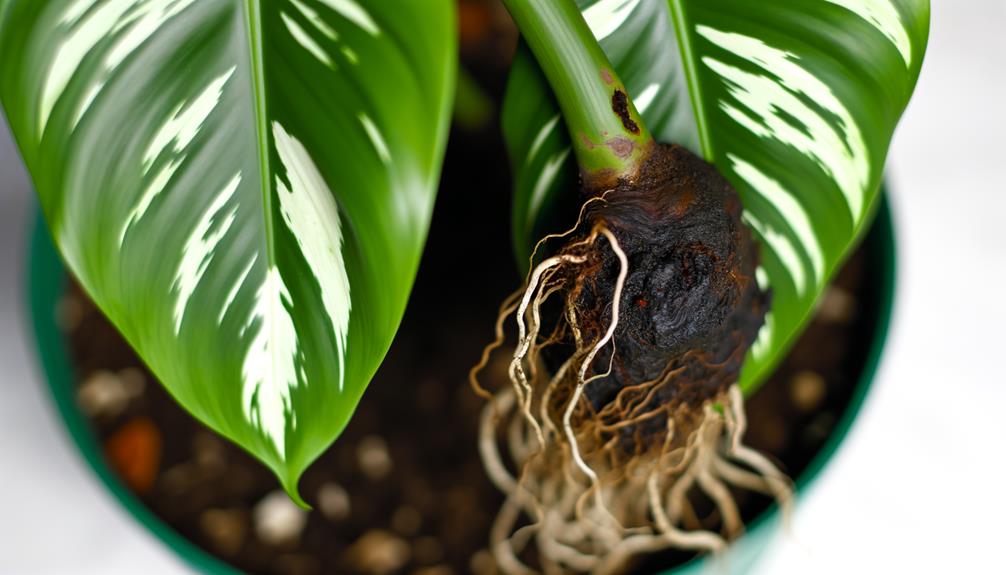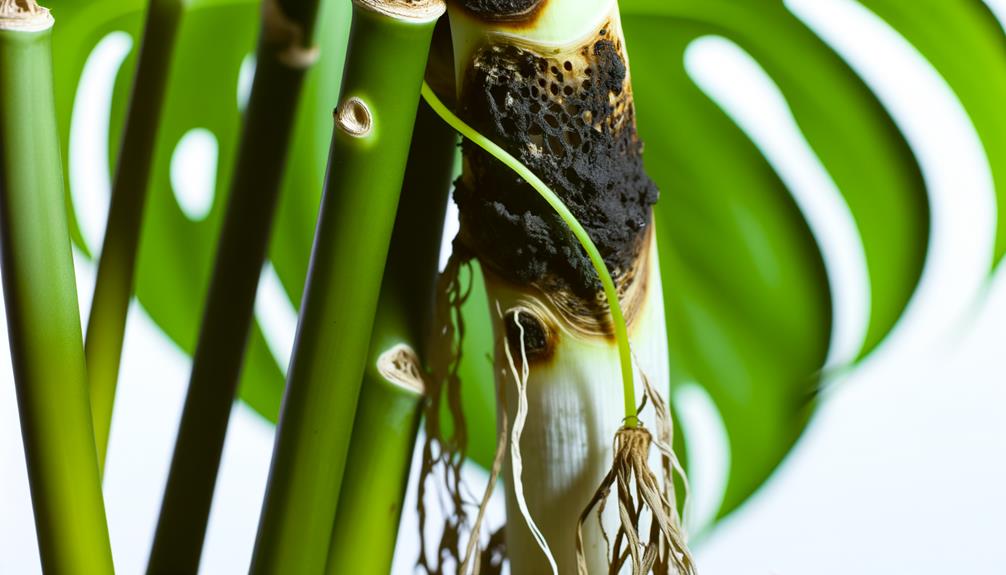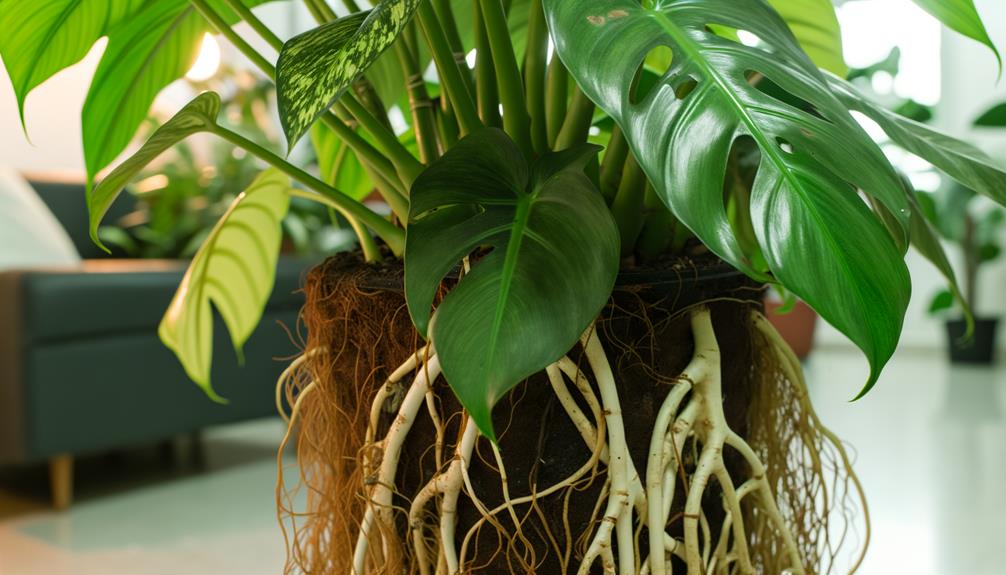Monstera Albo Aerial Root Rot
Monstera Albo's aerial root rot is often due to excessive moisture, leading to fungal or bacterial infections. You'll notice blackened, mushy roots that emit a foul smell, typical of Pythium or Phytophthora pathogens.
Healthy roots should be firm and light-colored. Overwatering, poor drainage, high humidity, and lack of airflow are common causes.
To treat, isolate the plant, trim infected roots, and repot in well-draining soil. Adjust your watering schedule and ensure good airflow to prevent recurrence.
Proper diagnosis and timely intervention are essential to saving your plant, and there's more to explore on effective care strategies.

Key Takeaways
- Aerial root rot in Monstera Albo is caused by excessive moisture, poor drainage, and high humidity.
- Symptoms include blackened, mushy roots with a foul smell and decreased plant growth.
- Prevent root rot by using well-draining soil, ensuring proper airflow, and avoiding overwatering.
- Trim affected roots with sterilized tools and repot the plant in fresh soil.
- Apply a fungicide and adjust watering practices to aid in recovery and prevent recurrence.
Understanding Aerial Root Rot

Aerial root rot in Monstera Albo occurs when the plant's above-ground roots are consistently exposed to excessive moisture, leading to fungal or bacterial infections. You'll notice root discoloration, typically dark brown or black, accompanied by a mushy texture. Healthy roots should be firm and light-colored.
Fungal pathogens, such as Pythium and Phytophthora, and bacteria like Erwinia, thrive in waterlogged conditions, accelerating tissue decay. If you observe a foul odor, it's another indication of rot. Use sterile pruning tools to inspect and trim affected areas.
Monitor the plant's environment, ensuring proper ventilation and humidity levels. By understanding these symptoms and employing timely intervention, you can mitigate the spread of aerial root rot and maintain your Monstera Albo's health.
Causes of Aerial Root Rot
Excessive moisture is the primary cause of aerial root rot in Monstera Albo, creating an environment conducive to fungal and bacterial infections. When water accumulates around the aerial roots, it restricts oxygen flow and promotes pathogenic growth.
Factors contributing to this issue include:
- Overwatering: Frequent watering saturates the aerial roots.
- Poor drainage: Inadequate drainage increases water retention.
- High humidity: Elevated humidity levels can lead to moisture accumulation.
- Lack of airflow: Limited air circulation fosters a damp environment.
Identifying Symptoms

When you suspect aerial root rot in your Monstera Albo, observe for visual rot indicators such as blackened, mushy roots.
Additionally, assess the texture of the roots; healthy roots should be firm, while rotting roots will feel soft and slimy.
Identifying these symptoms early is essential for effective intervention.
Visual Rot Indicators
Early signs of aerial root rot in Monstera Albo include the emergence of dark, mushy patches along the root surface. These patches indicate tissue breakdown and potential fungal or bacterial infestation.
To accurately diagnose root rot, closely inspect the following visual indicators:
- Color Change: Healthy roots are typically white or light brown. Rotting roots turn dark brown or black.
- Texture: Affected areas become mushy, losing their firmness.
- Odor: Decayed roots often emit a foul, musty smell.
- Spreading: The rot can progress rapidly, spreading to adjacent healthy roots.
Root Texture Changes
To identify symptoms of root texture changes, examine the aerial roots for any signs of mushiness or loss of structural integrity. Healthy roots should feel firm and resilient.
If you notice a soft, slimy texture, it indicates cellular breakdown due to rot. Additionally, compromised roots may exhibit discoloration ranging from brown to black.
Use gentle pressure to assess the root's consistency; a healthy root resists deformation, whereas a rotting root collapses easily. Pay close attention to any foul odors, as they signal anaerobic bacterial activity.
Monitoring these texture changes is essential for early detection and management of root rot, ensuring your Monstera Albo maintains prime health.
Accurate identification allows for timely intervention, potentially saving the plant from further deterioration.
Prevention Techniques
To prevent Monstera Albo aerial root rot, you need to implement proper watering practices and maintain adequate airflow.
Avoid overwatering by allowing the soil to dry out between watering sessions, which minimizes excess moisture that can foster rot.
Additionally, promote air circulation around the plant to reduce humidity levels and inhibit fungal growth.
Proper Watering Practices
Maintaining proper watering practices is crucial for preventing Monstera Albo aerial root rot. Overwatering or stagnant water conditions can create an environment conducive to fungal infections. To maintain ideal moisture levels without risking root rot, consider the following:
- Monitor soil moisture: Use a moisture meter or finger test to make sure the top 2-3 inches of soil are dry before watering.
- Use well-draining soil mix: Incorporate perlite or orchid bark to improve aeration and drainage.
- Water thoroughly but infrequently: Allow excess water to drain completely through the pot's bottom.
- Avoid waterlogging: Make sure pots have drainage holes and avoid leaving the plant in standing water.
Ensure Adequate Airflow
Maintaining proper watering practices is only part of the equation; providing sufficient airflow around your Monstera Albo prevents humidity buildup and fungal proliferation. Implementing a fan can promote air circulation, reducing moisture on aerial roots.
Position your plant where it receives indirect sunlight and avoid overcrowding it with other plants. Evaluate the ventilation, making sure windows are occasionally opened to enhance air exchange.
Observing the plant's environment aids in diagnosing potential issues early. Excessive humidity can be addressed by using a hygrometer to monitor levels. If detected, dehumidifiers can be used to maintain ideal conditions.
Immediate Actions
Upon identifying aerial root rot in your Monstera Albo, promptly isolate the affected plant to prevent the spread of pathogens.
Examine the plant thoroughly to assess the extent of the rot. Remove any visibly infected roots using sterilized tools to minimize contamination. Properly dispose of the infected plant material to avoid cross-contamination.
Key immediate actions include:
- Isolation: Place the afflicted plant away from healthy ones.
- Examination: Inspect for signs of rot, such as discoloration and mushiness.
- Sanitation: Sterilize cutting tools before and after use.
- Disposal: Seal and discard infected roots in a trash bag.
Treatment Methods
To effectively address aerial root rot in your Monstera Albo, apply a fungicide specifically formulated for houseplants, guaranteeing thorough coverage of the affected areas.
Trim away any visibly rotten or mushy roots using sterilized pruning shears to prevent further spread of the rot.
Afterward, allow the plant to dry out completely in a well-ventilated area, minimizing moisture around the aerial roots.
Ensure your Monstera is placed in an area with ideal light and airflow conditions to discourage fungal growth.
Regularly inspect the roots for any signs of recurrence.
Long-Term Care

After addressing the immediate treatment of aerial root rot, prioritize long-term care strategies to guarantee your Monstera Albo remains healthy and resilient. Consistent monitoring and preventive measures are important.
Implement these practices:
- Regular Inspection: Routinely check aerial roots for early signs of rot or distress.
- Humidity Control: Maintain ideal humidity levels (60-70%) to prevent excessive moisture and fungal growth.
- Proper Watering: Ensure soil is well-draining and avoid waterlogging; use a moisture meter for accuracy.
- Adequate Light: Place your plant in bright, indirect light to promote healthy growth and resistance to pathogens.
Common Mistakes
One common mistake is neglecting to inspect aerial roots regularly, leading to unnoticed early signs of rot. You should examine the roots for discoloration or mushiness, which are early indicators of fungal infection.
Another frequent error is overwatering, which creates an ideal environment for pathogens. Make sure the soil is well-draining to prevent water accumulation.
Additionally, improper air circulation can exacerbate rot. Position your Monstera Albo in a spot with adequate airflow to mitigate this risk.
Using contaminated tools can introduce harmful bacteria or fungi. Sterilize your pruning shears before use.
Conclusion
To sum up, tackling aerial root rot in your Monstera Albo demands attentiveness and timely action. Take Jane, for instance, who spotted darkened roots on her plant. By promptly trimming affected roots and enhancing air circulation, she effectively stopped the rot.
Consistently check your Monstera for initial signs and uphold ideal conditions to avoid reappearance. Your proactive strategy, paired with accurate diagnostic methods, guarantees your plant flourishes, free from the harmful impacts of aerial root rot.





